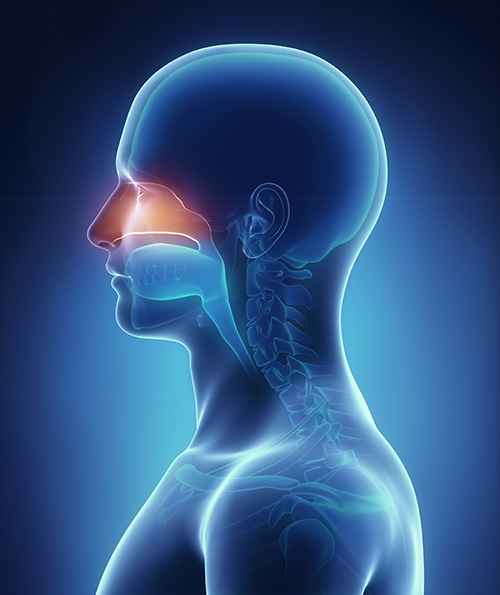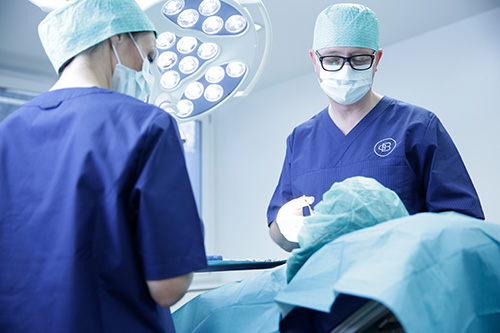We use proven examination procedures and the latest diagnostic methods to create a comprehensive picture of your situation and define the right treatment strategy for you.
The anatomical features of the upper airway from the nose to the pharynx to the larynx, and the position and posture of the lower jaw mutually define and influence both the function and the externally visible form, so treatment can sometimes be conservative and sometimes surgical.
The interfaces between medicine and dentistry in diagnostics and therapy are also particularly important here. Whether you suffer from obstructed nasal breathing, are affected by sleep apnoea syndrome or wish to have your nose aesthetically altered as part of a profile optimisation, you’re in the best hands with us.

Obstruction of nasal breathing can have a variety of causes which, after ruling out functional, infectious, allergic or other causes, may be due to your anatomy.
Nevertheless, obstructed nasal breathing is often not easily remedied simply by straightening the nasal septum (septoplasty) or reducing the turbinates (conchotomy), as performed by colleagues in otorhinolaryngology.
If the air inflow at the nasal entrance is additionally obstructed by an anatomical narrowing of the anterior nasal sections, as maxillofacial surgeons we can permanently widen the space into the nasal cavity by performing a suitable small osteotomy at the bony base of the nose.
This small procedure can be performed via a minimally invasive approach in the area of the oral vestibule without visible scars and can usefully complement the measures described above on the septum and turbinates.

Obstructive sleep apnoea syndrome (OSAS) is an increasingly common condition, but it is often wrongly assessed initially, and sometimes even underestimated. Sufferers complain of a gradual deterioration in performance with unpleasant tiredness during the day due to disrupted breathing at night. Disruptions with repeated and prolonged pauses in breathing lead to a critical reduction in blood oxygen saturation.
The consequences of untreated obstructive sleep apnoea syndrome include cardiovascular illnesses such as high blood pressure, heart attacks and stroke. Links with diabetes mellitus, migraines, depression, etc. have also been described. Patients are almost always snorers, but the causes are varied, meaning that not every snorer is an OSAS sufferer.
The treatment options are just as varied – depending on individual circumstances, these range from conservative behavioural measures to tooth-supported splints or nocturnal respiration equipment. Minor and more complex surgical procedures cannot be ruled out.
The perception of the nose in the face is determined to a decisive degree by the proportions of the middle and lower third of the face, i.e. the position of the upper and lower jaw in relation to each other. Correct diagnostics in the analysis of the profile is therefore of particular importance so that a nasal hump is not simply removed where a chinoplasty is actually needed.
Nevertheless, in addition to profile optimisation by skeletal measures or after an accident, an undesirable or disturbing nose shape can be straightened or improved by means of rhinoplasty if necessary.
We focus on maintaining a certain individuality without standardising the shape of the nose, so as to favourably influence the overall effect of the face and harmonise the proportions.


We perform an open rhinoplasty, in which the access is not only inside the nose, but also requires a small inconspicuous incision on the columella, as we are personally convinced that this is the only way to ensure sufficiently good control over all elements of the nasal architecture, even in complex cases.
In cases where work also needs to be done on the bony nasal skeleton, a small plastic plaster is attached to the bridge of the nose, which can be removed at the first follow-up after five to seven days.
After a nose operation, experience shows that downtime of two weeks must be assumed until the swelling and possible haematoma have largely gone down and are no longer so obvious. However, it takes much longer for the final result to be achieved.
© 2022 Dr. Dr. Daniel Brusco